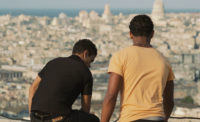For a certain audience (like, say, Architectural Record readers), Jane Jacobs is an old friend. Not only did her 1961 book The Death and Life of Great American Cities revolutionize how a generation of citizens view the urban space, she crusaded for the protection of neighborhoods and public infrastructure that give cities their flavor and verve.
But for more people than we might realize, Jacobs is an esoteric figure — if she’s even recognized at all — whose accomplishments are vague and, possibly, unknown all together. And it’s that group that director Matt Tyrnauer had in mind when constructing his documentary Citizen Jane: Battle for the City.
Opening in New York on April 21 and Los Angeles April 28, the ambitious 92-minute film is a lightning-round introduction to Jacobs and her place in the urban conversation. It’s also a primer on her nemesis Robert Moses, who at one point held 12 unelected positions across New York City and New York State. He wielded so much power, in fact, that he could strong-arm politicians and the public to develop destabilizing housing projects, superblocks, and neighborhood-gutting highways to reshape the cityscape in ways that prioritized cars over people.
Naturally, Citizen Jane spends a fair amount of time on Jacobs galvanizing her community to finally tell Moses “enough” — from the fight to save Washington Square Park in 1959 and Greenwich Village in 1961 to stopping the Lower Manhattan Expressway in 1962. But there’s so much ground covered in such a short span that you find yourself wishing for an eight-part, Ken Burns-style miniseries just to do everything justice.
Given that kind of density, there are places where you can feel trapped in tangential cul-de-sacs. The section on St. Louis’ Pruitt-Igoe Houses, for example, is interesting, but goes on far too long considering there are a couple good documentaries dedicated to only that subject. Yet while Tyrnauer disseminates history, background, anecdotes, and analysis at an odd pace, it is never less than authoritative. The film feels longer than its runtime, in the best possible way, and you find yourself craving more: more of Jacobs’ writing, more clips of Moses looking dour, more of the amazing footage of cities from around the world.
The film also benefits from the passage of time. When Tyrnauer began working on the film, few expected someone like Donald Trump would become President. But here we are, and the footage of Jacobs leading successful protests against titanic figures is inspiring and urgent. Her work is not only a guidebook for how to live in and manage cities; it’s a manual for successful civil disobedience. The tactic of deploying mothers to be the front-line faces in the fight for Washington Square Park still feels audacious. And mimicking the practice of taping X’s on the windows of condemning buildings by doing the same on eyeglasses and sunglasses remains inspired and, frankly, cool.
If nothing else, Citizen Jane shows that we can still learn from Jacobs. Her perspective and sensibilities are as necessary today as they were in the 1950s and ‘60s — maybe more so. And not just in New York, where questions of urban identity and neighborhood cohesion have flared in response to rising rents that have displaced long-time residents. These threats face people all over the world—especially in places like China and India.
America has mostly absorbed Jacobs’s teachings, observations, and lessons as best practices. But the rest of the planet is another story. The film presents scene after scene depicting visions from America’s past failures manifested across the developing world: slums, overcrowding, dehumanizing high rise towers, rows upon rows of superblocks. One person describes farmland that China is converting into urban areas as “Moses on steroids.”
That statement caught me completely off guard, and it should send a chill through every engaged viewer. It makes us consider the terrifying notion that while Jacobs won the battles in New York, her ideas may have lost the war. Despite it all, could Moses have prevailed? It’s a reality we’re loath to even contemplate. And yet, there are those Chinese superblocks and Indian slums. How do we account for them in the evolution of cities, post-Jacobs?
Citizen Jane does an excellent job of making the case for Jacobs, as if she needed any more defending. But in its ambition, it plants these disquieting notions about the future of the planet’s urban spaces and Jacobs’ place in it — and they remain with you long after you’ve left the theater, like splinters in your mind. That may not be what Tyrnauer intended, but it elevates his film beyond mere biography. Indeed, it challenges us to confront our own complacency. Just because Jacobs won in her day doesn’t mean fight is over. Clearly there’s much to be done, and this film at this moment is a call to arms.







Post a comment to this article
Report Abusive Comment